Case Studies
Industries
Resources
Ratings & Reviews
NEW
User Generated Content, why integrate it into your website? Maybe it’s the insane ROI, engagement and conversion rates associated with social User Generated Content. Integrating UGC enriches the online experience by fostering community engagement, authenticity, and diverse perspectives. Perhaps it’s because there are more opportunities to show off your fans and followers than ever. Check out how 14 brands are ruling instagram by adding customer photo examples to their UGC strategies. Read on for everything you need to know about why you should integrate UGC.
Modern marketers are using their own customers as cornerstones of their content strategies. You don’t have to spend more than a few seconds on Facebook or Instagram to see just how widespread UGC has become. From building trust to keeping customers glued to your product pages, UGC has gone from a growing trend to a marketing must-do. So don’t keep asking what’s UGC, start discovering what it can do for your brand.

Here’s the deal: your clients, customers and followers are creating and sharing content like never before. Integrating this content can be an successful part of your marketing strategy.
This includes 95 million photos and vidoes shared on Instagram daily and thousands of tweets per second. Oh, and don’t forget the 30 billion pieces of content published to Facebook monthly.
There’s no sign of a slowdown, either.
In the midst of so much noise, marketers have struggled to make their voices heard. Through User Generated Content, brands are finding unique ways to spin their social content into pure gold. By using followers as billboards and allowing their social feeds to serve as a digital shopping window, User Generated Content is influencing buyers like never before.
Integrating User Generated Content into websites enhances interactivity, fosters a sense of community, and adds authenticity to the platform. By allowing users to contribute their own content, websites can offer a more diverse range of perspectives and experiences, leading to increased engagement and loyalty from visitors. This content can serve as valuable social proof, influencing others to participate and driving traffic to the site.
Integrating User Generated Content into your emails like newsletters, order confirmation emails and membership confirmation emails, can make them more much engaging. The addition of UGC can drive a staggering 73% increase in email click-through rates (Salesforce) and DMA reported that email has the highest conversion rate (66%) compared to social, direct mail, and more. Here are some additional benefits to integrating UGC in email campaigns:
Flowbox provides brands with a versatile platform to seamlessly integrate UGC across various channels. By leveraging Flowbox, brands can curate authentic UGC from social media, reviews, and other sources, then feature it on their website, ads, newsletters, emails, and more. This integration not only enhances the brand’s authenticity but also fosters a sense of community engagement. With Flowbox’s user-friendly interface and customisation options, brands can easily showcase UGC to resonate with their audience and drive meaningful interactions across multiple touchpoints.

If you’re asking yourself why integrate User Generated Content, then look no further as we take through it’s benefits. If you’ve been sleeping on UGC or simply don’t know what all the hype is about, you’re certainly not alone. After all, it’s only natural for marketers to be skeptical of “the next big thing.” This is especially true with so many social trends that have come and gone.
However, it’s crystal clear based on marketing data, trends and modern best practices that UGC is here to stay.
So, why exactly does UGC deserve your attention? Below we’ve broken down the eight most notable benefits of integrating UGC. Furthermore, we’ve outlined how brands both big and small enjoy these benefits themselves.
There’s no better way to establish an emotional connection between you and your customers than through User Generated Content.
Think about it. Sure, massive brands on Instagram such as Nike and Gucci can get away with featuring all-star athletes and A-listers in their campaigns. Does that mean seemingly smaller brand are doomed because they can’t?
Of course not.
Your existing fans, followers and customers are arguably your best marketing firepower.
Consider how brands such as MAC still leverage UGC even though they have a massive following. Despite over 23 million followers on Instagram, they still rely on UGC to show off their products:
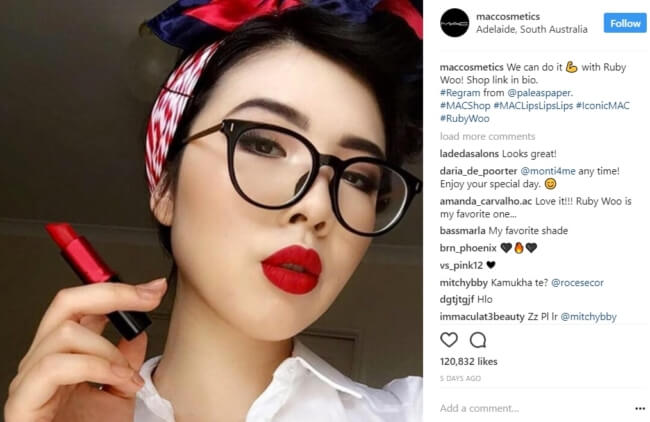
Remember that social content is the easiest way to open the lines of communication between you and your followers. Social followers strive to engage with brands, but it’s up to marketers to make those opportunities happen. Giving your followers a shout out or boost is a great way to establish a sense of brand loyalty.
That’s exactly how many of today’s fast food brands such as Wendy’s, Arby’s and Dunkin Donuts have gathered huge, cult-like followings via UGC. These brands are under no obligation to regram their followers, especially given their juggernaut marketing budgets. Even so, they frequently implement their followers’ content in their social feeds:
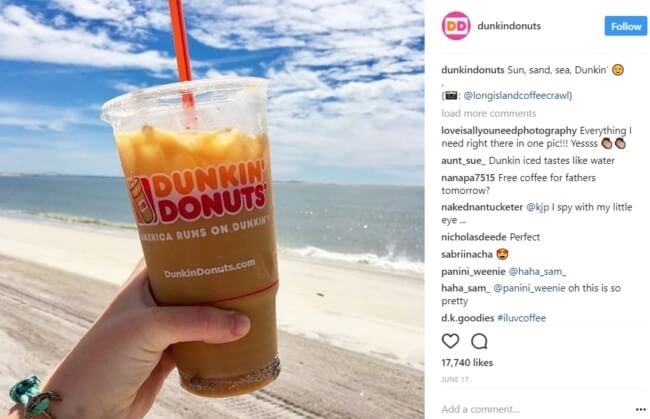
The takeaway here? Sometimes the content your followers are hungriest for isn’t your own.
Brands today could benefit from getting on the same level of their customers. This is especially true in an era where we’re bombarded with more marketing messages than ever.
Nobody wants to look at a social feed that feels like a laundry list of advertisements. Millennials in particular are sick of being sold to.
How does consumer content help to combat this feeling? Rather than forcing authenticity (hint: which isn’t authentic at all), UGC is genuinely authentic thanks to your customers.
For example, here’s a non-UGC post from Coastal that looks like a traditional promo post:

Sleek, but not much in terms of engagement beyond “likes,” right?
On the flip side, check out the love that this User Generated post received:

The biggest benefits of the User Generated Content is that you can show off your products “in the wild” and in real-world setting. When you integrate social media into your website makes what you’re selling more tangible and relatable to customers versus a mere product photo. As noted by this example, there’s a reason why User Generated photos receive more engagement from followers.
Another important lesson learned from this example is the fact that your social feeds aren’t expected to be made up of 100% UGC. That said, user submitted photos and regrams are a great way to make your feed seem more personal.

What’s UGC best for?
Simply put, UGC means less work on behalf of marketers while pushing out more content.
Consider the optimal times to post on social media, for example. Between Facebook, Twitter and Instagram alone, marketers are expected to come up with dozens of pieces of fresh content for their followers per week.
UGC presents a quick and easy opportunity for marketers to find and share new content in a snap.
For example, check out how Covergirl uses a mentioned tweet as a way to display their products and a hyped customer:
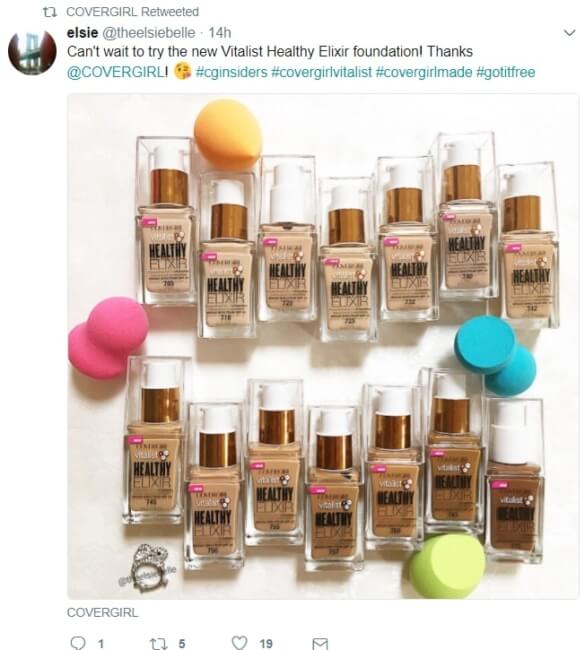
On Instagram, regrams via hashtag campaigns such as those often run by brands like Canon are also prime opportunities to leverage UGC:

Through hashtags, content discovery and curation on behalf of brands are arguably easier than ever. At the same time, these sorts of posts can be used in real-time to supplement any pre-scheduled content.
The end result is a more diverse content strategy that doesn’t put extra work on the backs of marketers.
Marketers should strive to follow the principle of “show, don’t tell.”
In other words, what your customers have to say about your brand and products speaks volumes over what you have to say.
That’s why social proof is so powerful. By letting your fans and followers sing your praises, brands can break down the trust barrier with skeptics. After all, today’s consumers are constantly searching for peace of mind before pulling out their wallets.
Bear in mind that over 92% of people read customer feedback prior to making a purchase. Customer photos and feedback are front and center for eCommerce giants like Amazon:
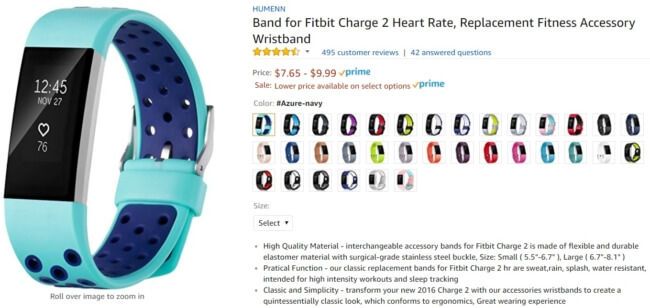
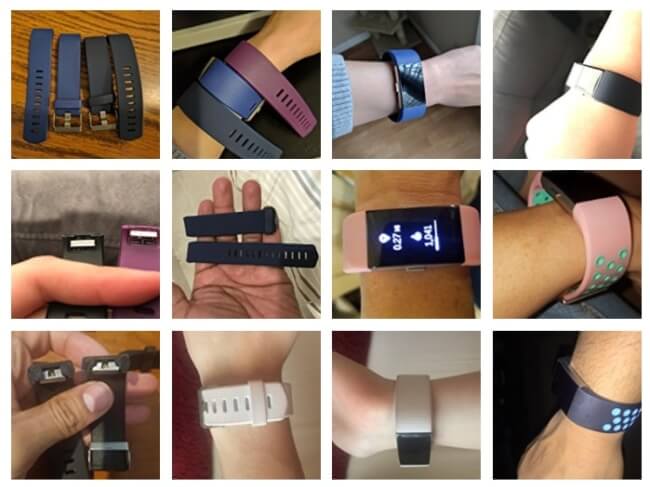
Similarly, Old Navy integrates customer star-ratings and reviews throughout their product pages:

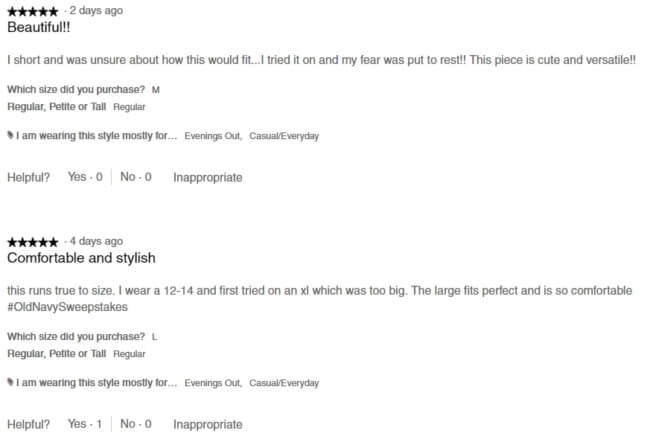
Such photos and reviews ultimately help potential buyers visualize themselves with products and reduce eCommerce returns.
Here’s some more food for thought: satisfied customers are arguably more powerful than traditional ads. This retweet from Skyscanner is a prime example of subtle advertising via positive customer feedback:

Rather than try to convince potential customers that you’re worth their time, User Generated Content allows you to show them.
What’s UGC doing for your brand? If the answer is nothing yet, then it’s probably time to change that.
Flowbox has noted firsthand how UGC improves conversions on behalf of clients. Beyond giving products a more human touch, shoppable Instagram feeds and product lookbooks provide additional opportunities to convert followers into customers.
There’s major marketing firepower in customer photos. INSIDE Shops’ customer lookbook is a prime example of how UGC can aid in converting buyers on the fence:
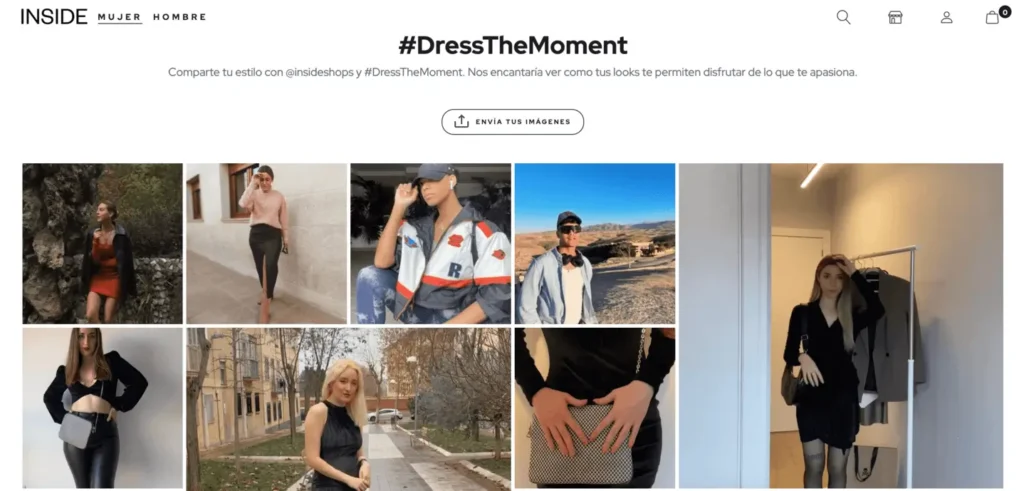
Lookbooks also give followers yet another chance to interact with your brand via hashtags. This sort of UGC is the perfect supplement on-site for your traditional product pages.
And while old-school product pages aren’t going anywhere, turning your customer photos into opportunities for sales is an added bonus for brands. Check out how Meller shows off customer photos in their lookbook…

…and makes them shoppable:
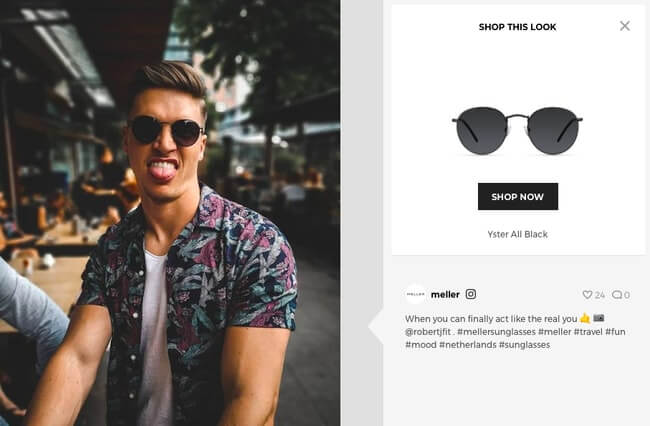
Your followers are more willing than ever to make purchases given the rise of social shopping. In a day and age where three-quarters of shoppers are influenced by social content, anything marketers can do to increase conversions is a major bonus.
How does the performance of UGC compare to the performance of Promotional Content?
Plain and simple, people are more likely to engage with User Generated Content versus any other type of content.
Many marketers struggle to find the right ratio with their social content. They try hard not to come off as too salesy or self-promotional. UGC makes it easier for marketers to meet those ratios without seeming like a spammer.
For example, the two most common are the old-school 80/20 rule and the “rule of thirds.”
The 80/20 is simple. The thesis is this: 80% of your content should be educational or entertaining and 20% should be promotional. Such a ratio discourages too much in-your-face advertising and encourages subtle selling.
Meanwhile, the rule of thirds splits your content into three categories. That is, one-third of all content should be promotional, one-third should be informational or educational, and the final third should be someone else’s content. This ratio encourages sales-based content every third post.
Regardless of which you follow, UGC allows you to double-dip entertaining or educational content with promotional content without sacrificing likes or shares.
Check out how TopShop promotes their products directly through UGC and how much love their posts get from followers:
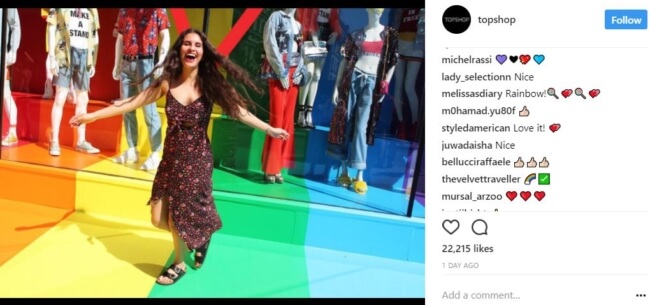
Nearly 95% of those under the age of 35 follow brands on social media while older age groups aren’t far behind. As such, promotion via UGC has not only become an expectation of marketers but of consumers as well. Without being too in-your-face, UGC encourages engagement and sales simultaneously.
What’s UGC doing for your brand? If you haven’t started using it, try it out and be amazed watching your engagement increase.
On a related note, marketers today are tasked with keeping their budgets as lean as possible. Curating UGC serves as an alternative for splashing cash for social ads or PPC, requiring an investment of time versus dollars and cents.
Even major brands like Nikon run UGC, signaling that there’s power in UGC for brands of all sizes:

Meanwhile, it obviously makes sense for brands to monetise their current base of followers and past buyers if possible. UGC allows brands to continuously advertise to existing followers while also piquing the interest of new ones. Additionally, social posts from flesh-and-blood people feel much more like a commercial than a paid ad.
Fashion brands perhaps have the most to gain from UGC. Even brands that do run paid promotions such as TeeFury can use their followers as ads:

Beyond being your hottest leads, social followers are easily your most qualified customers. Financially, brands with sizeable following arguably have the most to gain from UGC. In fact, it costs five times as much to attract a new customer, than to keep an existing one.
In short, UGC and hashtags serve as cost-effective advertising alternative for brands of any size.
So many brands flounder via social because they ignore the concept of community.
Through User Generated Content, brands can connect followers with like-minded fans owning the exact same interests. That’s why inspo posts are so popular for brands such as NYX, looking to both promote products and inspire followers:
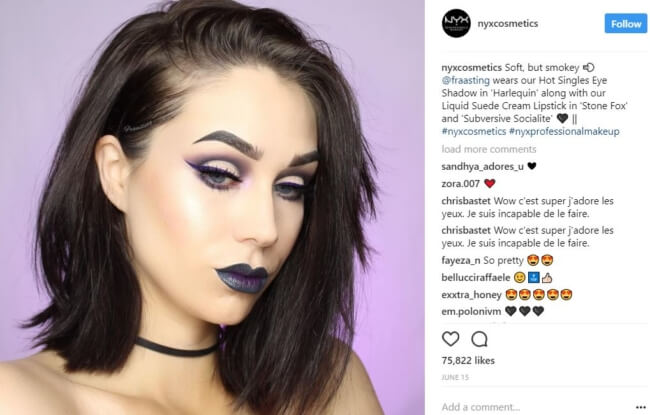
Also note how boosting your fans and followers can put your brand in a better light. Brands such as LuLaRoe thrive on a sense of community that’s both supportive and positive:

For those looking to build an actual community out of their social followers, User Generated Content is essential. Rather than struggle to come up with new content ideas, brands should allow their followers to do the legwork for them. Finally, supporting a community is crucial for encouraging repeat business rather than one-off buyers.
To harness the power of UGC effectively, brands must develop a well-thought-out strategy tailored to their objectives and audience. This entails encouraging active participation, curating high-quality content, and leveraging various channels for distribution and amplification. In the following list, we delve into five key tips essential for crafting a successful UGC strategy that drives meaningful results and strengthens brand-consumer relationships. Take a look at our top tips for building a strong strategy:
We hope that you’re not still asking yourself User Generated Content, why integrate? The beauty of User Generated Content is that brands have tons of options and opportunities. With no one-size-fits-all strategy to follow, the sky’s the limit for savvy brands.
Retweets. Regrams. Customer photos. Shoppable social feeds. Ratings and reviews.
And that’s just for starters. If you have a product and social followers, you have what it takes to get started with User Generated Content. With 79% people saying UGC highly impacts their purchasing decisions, ask yourself: what’s holding you back from doing the same?
UGC is becoming increasingly integral to modern content marketing across just about all industries. From eCommerce to brick and mortar shops, these eight benefits alone should be motivation for skeptical marketers to start implementing User Generated Content sooner rather than later.
What do you feel is the biggest benefit of a content strategy rooted in UGC? Do you think User Generated advertising is en route to completely overtake old school ads? Let us know in the comments below.